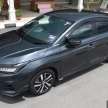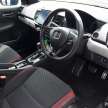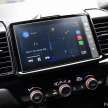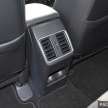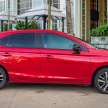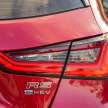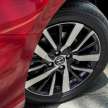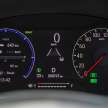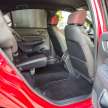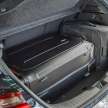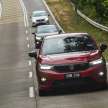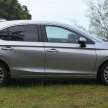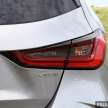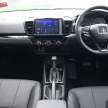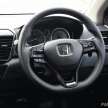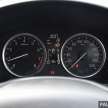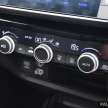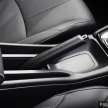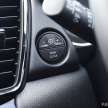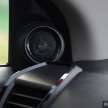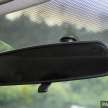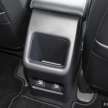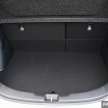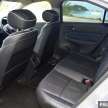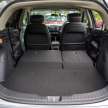In Car Reviews, Cars, Honda / / / 12 comments 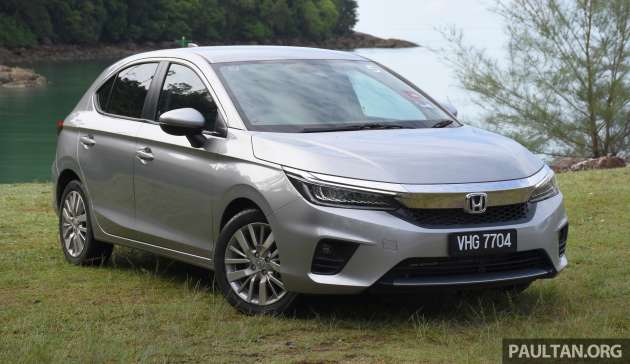
I’ve always had a fondness for the Honda Jazz, particularly the second- and third-gen iterations of the nameplate. Shape aside, of which the second-gen GE remains my pick, there was always an element of fun and lightheartedness to it, a hatchback that didn’t take itself too seriously but did what it was supposed to do, faultlessly.
Sure, it wasn’t perfect, but it had great practicality and, most importantly, character, enough that it resonated with more than 100,000 buyers here over three generations. So when the fourth one appeared on the horizon three years ago, the expectation was that it would carry on flying the flag for the small runabout.
That of course never happened, the car being replaced in the scheme of things by the vehicle we’re discussing today, the City Hatchback, which made its local debut last December. The reasoning behind the switch, as the company put it in an interview with the car’s large project leader, was down to playing on the recognisable imprint of the City nameplate in the region and maximising efficiency by building both sedan and hatchback variants based on the same platform.
It’s hard to argue against something like the economies of scale, but just how does the City Hatchback measure up? Does it ably fill the slot left vacant by the Jazz? Is it a better car than the one it replaces? An invitation by Honda Malaysia to put the car through its paces in Langkawi earlier this month answered some of the questions.
A change in projection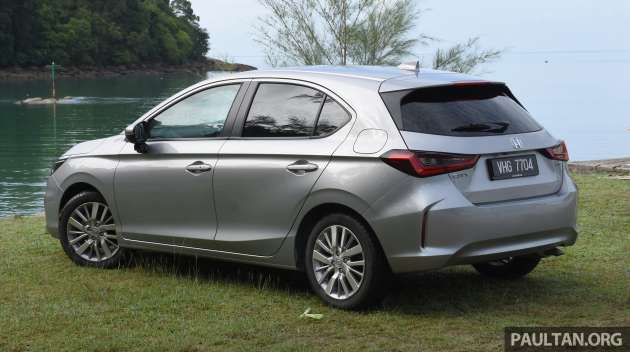
Where the last iteration of the Jazz had an avant-garde feel to it (and the new one, even more so), the same cannot be said of the City Hatchback. For the most, the lines mimic the sedan, with the same front end and doors. The lopped off rear means that there’s a new tail assembly, complete with new tail lights, the design of which looks like you’ve seen it somewhere before.
It’s not a bad looking car, very easy on the eye from certain angles, but it is rather traditional in its approach as to how a hatchback should shape up. The base form looks a tad plain on its own, as exemplified by the V. The RS e:HEV, especially with the Modulo elements, shows what a little dressing up can do.
Granted, this is meant to be a purposeful, practical car, one that can meet the billing of family requirements as well that of younger drivers, but correct me if you will, a hatch has always been geared towards buyers looking for a sportier proposition – never mind that it doesn’t go fast, it just has to look that. Decked out, the City Hatchback passes muster on that count – you won’t mistake it for a barnstormer, but it’s not dowdy.
Interior format from the sedan retained
As previously stated, measuring in at 4,345 mm long (4,349 mm for the RS), 1,748 mm wide and 1,488 mm tall, the car is longer and wider than the Jazz, but not as tall as the latter’s 1,524 mm height. Despite this, there’s plenty of space where rear occupants are concerned – clever packaging and Ultra Seats from the Jazz means there’s plenty of legroom, more than that of the sedan, even with the front seats slid back to accommodate lankier front occupants.
Where the hatch falls slightly short is in boot space. Losing 200 mm to the sedan means that the 519 litres seen on that is a pipe dream for the Hatchback – it delivers 289 litres of boot space with the seats up, which is less than that of the Jazz (363 litres).
With the rear seats folded down, the available volume (until the window line) goes up to 841 litres, but even on this count, the Jazz trumps it by offering 40 litres more. On the drive, the cargo space was able to accommodate smaller cabin-sized bags without fuss, but it looks like the aim of the design has been to maximise space for occupants.
The lack of tail-end acreage is only under consideration if cargo hauling space is essential – I have a feeling that for the intended audience, this will be of little consequence; those wanting more would already have opted for the sedan.
Otherwise, the cabin is a dead ringer for the sedan, including the dashboard, three-spoke steering wheel and front seats. In Langkawi, only the V and RS hybrid were presented on the drive, and equipment specs for the former include leather upholstery, soft-touch dash trim in black, an eight-inch infotainment touchscreen with Apple CarPlay and Android Auto connectivity and an eight-speaker audio system.
Also on the kit list are a reverse camera, remote engine start, single-zone automatic climate control, paddle shifters and cruise control. The RS adds on leather and suede combination upholstery, alloy pedals, black headlining, red illumination for the air-con controls as well as a seven-inch TFT instrument display and rear air-con vents, the only variant in the hatch line-up to have it.
In general, the cabin is a comfortable place to be in over long periods – I spent more than a week with the RS sedan late last year and particularly liked the sense of spaciousness in the cabin and how most things are presented – this was mirrored by the hatch during the drive. There’s still some cheap plastic feel to some bits, but thankfully they’re largely away from major contact points.
Same engines and safety kit
No change to the powertrain and drivetrain line-up – the Grade S, E and V variants all feature an L15Z 1.5 litre DOHC i-VTEC four-cylinder, paired with an Earth Dreams CVT and offering 121 PS at 6,600 rpm and 145 Nm at 4,300 rpm.
Meanwhile, the RS has the same i-MMD system as seen on the hybrid version of the sedan, consisting of a primary electric traction motor with 109 PS and 253 Nm providing drive through a single-speed transmission, with an Atkinson-cycle version of the 1.5 litre mill acting as a generator to recharge the battery. The mill, which has 98 PS from 5,600 to 6,400 rpm and 127 Nm between 4,500 and 5,000 rpm, can also clutch in to provide mechanical drive at higher running speeds.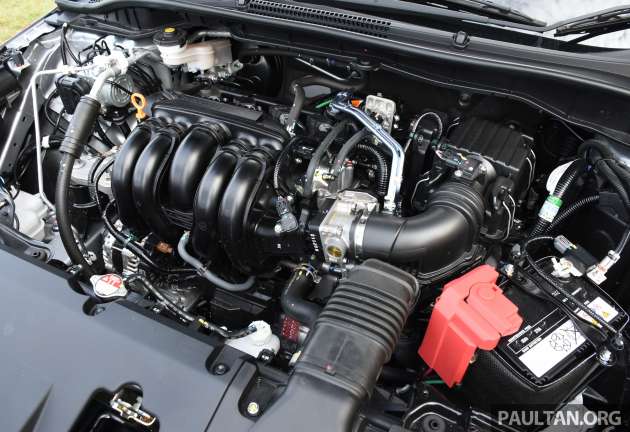
As for safety, up to the point of the drive, only the RS e:HEV came equipped with the automaker’s Sensing suite of driver assistance kit. Since then, the company has announced the V-Sensing, which now sits in between the standard Grade V and RS in terms of placement.
On the City, the suite is made up of adaptive cruise control, autonomous emergency braking with pedestrian, cyclist and oncoming vehicle detection, forward collision warning, lane keep assist system, road departure mitigation, lane departure warning and auto high beam. As it is with the sedan, there’s no Low Speed Follow function.
All that bit firmer, yes
If you believe the sell made on the on-paper qualifications for the i-MMD, you’ll have it being as good as a 2.5 litre mill in terms of pull. The reality, however, says otherwise. What’s on call in the RS hatch (and sedan) provides decent tractability, but nowhere as blistering as the shout makes it to be, especially when you floor it from standstill.
Sure, it’s a bit faster than the V off the bat to the century, but in a system geared more for efficiency (and fuel savings) rather than pure performance the differences are marginal. The major difference is that the hybrid does feel more organic – and quieter – in how it climbs up the speed scale under acceleration.
Floor the V and there’s a wall of noise, both from the engine and CVT, the latter displaying the whine associated with the type. Parity comes when you’re on the move, and at intermediate speeds, the in-gear movement coming off the petrol variant actually feels snappier, the response cleaner. Actually, if you’re not the sort to floor the accelerator all the time to get where you want to go, you probably won’t find the petrol-only version lacking, because it is tractable.
Where the difference lies is in the economical nature of the hybrid, as attested by previous long-stint runs with the City RS sedan. Matthew and Danny averaged around 26 and 25 km per litre, the latter over an intra-urban run. Even with a more lead-footed approach, all exclusively over short haul drives within the Klang Valley, I obtained a 22.5 km per litre return, something that would be impossible to match with the petrol variant. Of course, whether it is worth forking out the extra dosh for this ability is another matter entirely.
In terms of ride, both the V and RS offer the same level of comfort, which is best described as nuggety. It’s not jarring, but the distinctly firmish feel in its secondary ride follows the intended projection scoped for it, which is to offer the car a sportier feel.
That doesn’t quite translate all the way to handling, which is competent and composed, but not terribly engaging – in this regard it feels more civilian than sport. Much of the detachment comes from a steering devoid of feel, but the chassis responds well enough to keep things tidy and neutral, if a little nose heavy at times.
About the only real minus is with road noise picked up from the tyres. Hondas aren’t particularly known for their isolation from this, and it’s the one thing that kept surfacing across the drive.
While attention has been paid to insulating the cabin from other aural intrusions, namely sound deadening mats in the engine bay and polyurethane foam injected into specific areas of the car’s steel structure to reduce NVH levels, the absence of dampening material in the wheel wells means that you do get a fair bit of tyre roar, made all the more apparent because of the reduction of noise from elsewhere.
What’s the call then?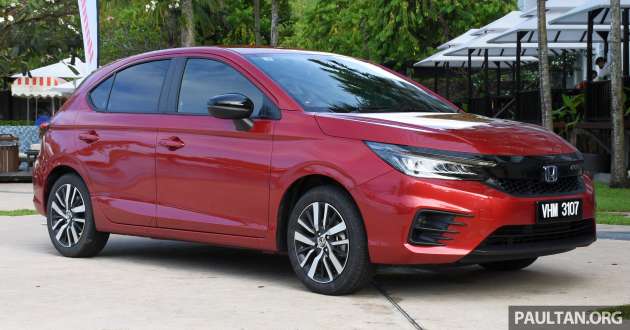
By mimicking most of the workings of the City sedan but packaging it in a sportier (well, at least perceived) body type, the automaker is hoping to catch younger buyers wanting the practicality of a City but for which the extra boot space isn’t a necessity, and for which a hatchback is seen as something that projects a more free-spirited nature.
Will it work? Well, given the growing number of City Hatchbacks on the road, it seems to be, and Honda will be banking on the newfound similarities closing the sales gap between sedan and hatch that was quite wide (in favour of the former) when the Jazz was around.
The pick of the lot from a technical viewpoint would be the RS, given its green leanings, very much in line with the current ethos. However, at RM107,783, it’s nearly RM20k more than the RM87,856 Grade V, which manages what the RS does for the most part. Even with Sensing added in, the particular V is still over RM16k cheaper at RM91,708. If it feels like a tough ask, it probably is.
Away from that, it’s a well-presented and practical car, the City Hatchback, and it feels all grown up from before. However, to answer the question posed at the start, it’s not necessarily better, just different. Take that how you will.
GALLERY: Honda City Hatchback RS e:HEV
GALLERY: Honda City Hatchback 1.5 V
Tags: Honda City Hatchback 2022
Research Honda Cars at ![]()
Comments
Bought it one. Hatchback. Terrible road noise and rattling fittings here and there. But yeah, honda. what can goes wrong
Still no 360 camera and no blind spot monitor? No buy
This is why the Yaris and Vios are still the best kitted out non-national B-segment,
But I still keep my Jazz. Jazz still looks better than City hatchback
What, a City needs 100k!!??
Just bought city hatchback for 3 months ago but never buy honda again. Got abnormal noise from steering rack. Keep replacing and replacing steering rack for 2 times then come back again.
Ativa or Myvi is better choice
the bonnet is so straight and high it is the same height as the window line. so ugly
smart ppl buy nissan almera
On this time try be find to me honda jazz 7 speed…contact me at +60104640901
Wait, a written article from anthony? I thought paultan went away with this format after what seemed like a loooooooooooooong season of video-only reviews. I came across this entirely by accident! So happy to see this again!
In the old days, the Jazz had exactly the same front/middle as the City, then they diverged, and now they’re back together – but with the Jazz name dropped. I think that’s a pity – the Jazz always seemed more fun that the boring square City, and the name is nicer too.
Add a comment
required
required
Car Reviews
Car Launches
![]()
Copyright © 2022 Driven Communications Sdn Bhd. All Rights Reserved.


